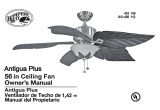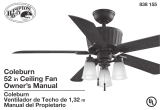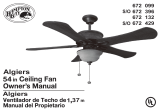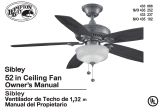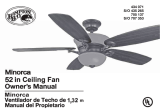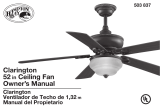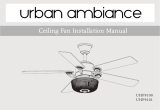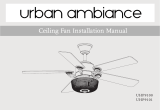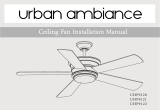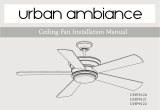Page is loading ...

60” Asbury Plus
Ceiling Fan by Hampton Bay
Accu-Arm™ for Accurate
and Easy Installation
Steeper Blade Pitch for
Greater Air Movement
3-Speed Reverse Function for
Year-Round Comfort and Savings
Tri-Mount Installation
QUESTIONS, PROBLEMS, MISSING PARTS:
Before returning to your local Home Depot, please call our
Customer Service Team at 1-877-527-0313 or visit www.homedepot.com.
Please reference your SKU (434 149 oil-rubbed bronze, 434 346 brushed nickel, 873 937 gilded espresso)
or UPC (082392 266028 oil-rubbed bronze, 082392 266127 brushed nickel, 082392 266929 gilded espresso).
Thank you for purchasing this Hampton Bay ceiling
fan. This product has been manufactured with the
highest standards of safety and quality. The nish
of this fan is weather resistant, but over time will
naturally weather and fade.
Safety Rules ........................................1
Unpacking Your Fan ..........................2
Installing Your Fan ............................3
Operating Your Remote Control ......11
Operating Your Fan ...........................12
Care of Your Fan ................................13
Troubleshooting .................................. 13
Specications ......................................14
Warranty Information .......................15
Table of Contents
UL Model No. 60-ABR

Safety Rules ........................................1
Unpacking Your Fan ..........................2
Installing Your Fan ............................3
Operating Your Remote Control ......11
Operating Your Fan ...........................12
Care of Your Fan ................................13
Troubleshooting .................................. 13
Specications ......................................14
Warranty Information .......................15
1. To reduce the risk of electric shock, insure electricity
has been turned off at the circuit breaker or fuse box
before beginning.
2. All wiring must be in accordance with the National
Electrical Code ANSI/NFPA 70-1999 and local electrical
codes. Electrical installation should be performed by a
qualied licensed electrician.
3. WARNING: To reduce the risk of re or electric shock, do
not use this fan with any solid-state speed control device.
4. CAUTION: To reduce the risk of personal injury, use only
the screws provided with the outlet box.
5. The outlet box and support structure must be securely
mounted and capable of reliably supporting 35 lbs. (15.9
kg). Use only UL Listed outlet boxes marked “Acceptable
for Fan Support of 35 lbs. (15.9 kg) or less.”
6. The fan must be mounted with a minimum of 7 feet
clearance from the trailing edge of the blades to the oor.
7. Do not operate reversing switch while fan blades are in
motion. Fan must be turned off and blades stopped before
reversing blade direction.
8. Avoid placing objects in path of the blades.
9. To avoid personal injury or damage to the fan and other items,
be cautious when working around or cleaning the fan.
10. Do not use water or detergents when cleaning the fan or fan
blades. A dry dust cloth or lightly dampened cloth will be
suitable for most cleaning.
11. After making electrical connections, spliced conductors
should be turned upward and pushed carefully up into
outlet box. The wires should be spread apart with the
grounded conductor and the equipment-grounding
conductor on one side of the outlet box, and the ungrounded
conductor on the other side of the outlet box.
12. Electrical diagrams are for reference only. Light kits that are
not packed with the fan must be UL listed and marked suitable
for use with the model fan you are installing. Switches must be
UL General Use Switches. Refer to the instructions packaged
with the light kits and switches for proper assembly.
13. All set screws must be checked and retightened where nec-
essary before installation.
Safety Rules 1.
READ AND SAVE THESE INSTRUCTIONS
TO REDUCE THE RISK OF FIRE, ELECTRIC SHOCK OR PERSONAL
INJURY, MOUNT TO OUTLET BOX MARKED ACCEPTABLE FOR FAN
SUPPORT OF 35LBS (15.9 KG) OR LESS AND USE SCREWS PROVID
-
ED WITH THE OUTLET BOX.
PLEASE REMOVE RUBBER MOTOR STOPS ON THE BOTTOM OF THE
FAN BEFORE INSTALLING BLADES OR TESTING THE MOTOR.
TO REDUCE THE RISK OF PERSONAL INJURY, DO NOT BEND THE
BLADE BRACKETS WHEN INSTALLING THE BRACKETS, BALANCING
THE BLADES, OR CLEANING THE FAN.

a. Blade attachment hardware
(15 screws)
b. Electrical & Mounting Hardware
(3 plastic wire connectors, 1 hanger pin, 1
locking pin, 1 rubber gasket)
c. Extra Plug (for non-light kit use)
d. Extra Blade Bracket Attachment
Hardware
(1 screw and lockwasher)
7. Glass Bowl
8. Bulbs (3)
9. Light Kit
10. Decorative Motor Collar Cover
11. Remote Control & Receiver
1. Slide-On Mounting Plate (inside canopy)
2. Canopy with Canopy Ring attached
3. Downrod and Hanger Ball Assembly
4. Blade Bracket (Flange) Set (5)
with blade bracket screws pre-installed
5. Fan Motor Assembly
6. Blades (5)
2. Unpacking Your Fan
IMPORTANT: THIS PRODUCT AND/OR COMPONENTS ARE COVERED BY
ONE OR MORE OF THE FOLLOWING U.S. PATENTS: 5,947,436; 5,988,580;
5,971,573; 6,010,110; 6,010,306; 6,039,541; 6,046,416 AND OTHER
PATENTS PENDING.
Unpack your fan and check the contents. You should have the following items:
1
3
5
6
8
7
9
4
10
2
11
c
ab
d

Installing Your Fan 3.
Tools Required
Phillips screw driver, straight slot screw
driver, adjustable wrench, step ladder, and
wire cutters.
Mounting Options
If there isn’t an existing outlet box, then read
the following instructions. Disconnect the
power by removing fuses or turning off
circuit breakers.
Secure the outlet box directly to the building
structure. Use appropriate fasteners and
building materials. The outlet box and its
support must be able to fully support the
moving weight of the fan (at least 35 lbs.)
Do not use plastic outlet boxes.
Figures 1, 2, and 3 are examples of different
ways to mount the outlet box.
Outlet Box
Outlet Box
Recessed
Outlet Box
Ceiling
Mounting
Plate
Provide Strong
Support
Note: You may need a longer downrod to
maintain proper blade clearance when install-
ing on a steep, sloped ceiling. The maximum
angle allowable is 30˚. If the canopy touches
downrod, remove the decorative canopy
bottom cover and turn the canopy 180˚ before
attaching the canopy to the mounting plate.
Outlet Box
To hang your fan where there is an existing
xture but no ceiling joist, you may need an
installation hanger bar as shown in Figure 4
(available at your Hampton Bay retailer).
TO REDUCE THE RISK OF FIRE, ELECTRIC
SHOCK OR PERSONAL INJURY, MOUNT
TO OUTLET BOX MARKED “ACCEPTABLE
FOR FAN SUPPORT OF 35LBS. (15.9 KG)
OR LESS”, AND USE SCREWS PROVIDED
WITH THE OUTLET BOX. OUTLET BOXES
COMMONLY USED FOR THE SUPPORT OF
LIGHTING FIXTURES MAY NOT BE ACCEPT-
ABLE FOR FAN SUPPORT AND MAY NEED TO
BE REPLACED. CONSULT A QUALIFIED ELEC-
TRICIAN IF IN DOUBT.
Figure 1
Figure 2
Figure 4
Figure 3

different procedures to follow for the two
types of installation.
Standard Ceiling Mounting
1. Remove the canopy ring from the canopy
by turning the ring to the right until it
unlocks (Figure 5).
2. Remove the mounting plate from the
canopy by loosening the four screws on
the top of the canopy. Remove the two
non-slotted screws and loosen the slotted
screws. This will enable you to remove the
mounting plate (Figure 6).
4.
Hanging the Fan
REMEMBER to turn off the pow-
er. Follow the steps below to hang your
fan properly.
NOTE: This ceiling fan is supplied with two
types of hanging assemblies; the standard
ceiling installation using the downrod with
ball and socket mounting, and the “close-to-
ceiling” mounting. The “close-to-ceiling”
mounting is recommended in rooms with
less than 8-foot ceilings or in areas where
additional space is desired from the oor
to the fan blades. When using standard
downrod installation, the distance from the
ceiling to the bottom of the fan blades will be
approximately 12 inches. The “close-to-ceiling”
installation reduces the distance from the
ceiling to the bottom of the fan blades to
approximately 7 inches.
Once you have decided which ceiling
installation you will use, proceed with the
following instructions. Where necessary,
each section of the instructions will note the
Remove
Loosen but Do
Not Remove
Figure 6
Figure 7
3. Route the wires exiting the top of the
fan motor through the decorative motor
collar cover then the canopy ring. Make sure
the slot openings are on top. Route the wires
through the canopy and then through the
ball/downrod assembly (Figure 7).
Position
Locked
Pin in
Locking
Pin
Hanger Pin
Collar
Motor
Tighten Screws
Canopy Ring
Canopy
Motor Wires
Ball/Downrod
Assembly
Hook
Ceiling
Mounting
Plate
Mounting
Screws
(Supplied With
Outlet Box)
UL Listed
Outlet
Slide Mounting
Plate Over
Screw Heads
120V Wires
Motor
Collar
Cover
WHEN MOUNTING THE FAN ON A SLOPED
CEILING, THE STANDARD BALL/DOWNROD
MOUNTING METHOD MUST BE USED. THE
MOUNTING PLATE MUST BE MOUNTED SO
THAT THE SLOT OPENINGS ARE ON THE
LOWER SIDE BY SLIDING THE MOUNTING
PLATE FROM THE TOP DOWN. FOR A GREATER
MOUNTING ANGLE, REMOVE THE DECORA-
TIVE CANOPY BOTTOM COVER (FIGURE 9).
Turn Canopy Ring to Remove
Figure 5

“Close-to-Ceiling” Mounting
1. Remove the canopy ring from the canopy
by turning the ring to the right until it
unlocks (Figure 5).
2. Remove the mounting plate from the cano-
py by loosening the four screws on the top
of the canopy. Remove the two non-slotted
screws and loosen the slotted screws. This
will enable you to remove the mounting
plate (Figure 6).
3. Remove the decorative canopy bottom cov-
er from the canopy by depressing the three
studs (Figure 9).
4. Remove three of the six screws and lock-
washers (every other one) securing the mo-
tor collar to the top of the fan motor housing
(Figure 10).
5. Place the rubber gasket over the remain-
ing three screws, route the wires exiting
the top of the fan motor through the canopy
ring (make sure the slot openings are on
top), then proceed to place the ceiling can-
opy over the collar at the top of the motor
(Figure 11).
5.
4. Loosen, but do not remove, the set
screw on the collar on the top of the
motor housing.
5. Align the holes at the bottom of the
downrod with the holes in the collar
on top of the motor housing (Figure 7).
Carefully insert the hanger pin through
the holes in the collar and downrod. Be
careful not to jam the hanger pin against
the wiring inside the downrod. Insert the
locking pin through the hole near the
end of the hanger pin until it snaps into its
locked position, as noted in the circle inset
of Figure 7.
6. Re-tighten the set screws on the collar on top
of the motor housing (Figure 8).
7. Proceed to “Installing the Fan” section.
FAILURE TO PROPERLY INSTALL SET SCREWS
IN STEP 7 COULD RESULT IN FAN LOOSENING
AND POSSIBLY FALLING.
FAILURE TO PROPERLY INSTALL THE LOCK-
ING PIN AS NOTED IN STEP 5 COULD RESULT
IN FAN LOOSENING AND POSSIBLY FALLING.
Figure 9
Canopy
Bottom
Cover
Figure 10
Figure 11
Motor
Collar
Screw and
Lockwasher
(3 of 6 Screws)
Collar
Screw and
Lockwashe
r
(3 Screws)
Ceiling
Canopy
Canopy
Ring
Rubber
Gasket
6. Align the mounting holes with the holes
in the motor and fasten, using the three
screws and lock-washers removed in step 4
(Figure 11).
7. Tighten the mounting screws securely.
Figure 8
Tighten
Set
Screws

6.
WHEN USING THE STANDARD BALL/DOWNROD
MOUNTING, THE TAB IN THE RING AT THE BOT-
TOM OF THE MOUNTING PLATE MUST REST IN
THE GROOVE OF THE HANGER BALL. FAILURE
TO PROPERLY SEAT THE TAB IN THE GROOVE
COULD CAUSE DAMAGE TO WIRING.
Installing Fan to
the Outlet Box
WHEN MOUNTING THE FAN ON A SLOPED
CEILING, THE STANDARD BALL/DOWNROD
MOUNTING METHOD MUST BE USED. MAKE
SURE THE MOUNTING BRACKET SLOTS ARE
ON THE LOWER SIDE BY SLIDING THE MOUNT-
ING BRACKET FROM THE TOP DOWN.
1. Pass the 120-volt supply wires through the
center hole in the ceiling mounting bracket
as shown in Figure 7.
2. Install the ceiling mounting plate on the out-
let box by sliding the mounting plate over
the two screws provided with the outlet
box. When using close-to-ceiling mount-
ing, it is important that the mounting plate
be level. If necessary, use leveling washers
(not included) between the mounting plate
and the outlet box. Note that the at side of
the mounting plate is toward the outlet box
(Figure 7).
3. Securely tighten the two mounting screws.
4. Carefully lift the assembly up to the ceil-
ing mounting plate. If using Close-to-
Ceiling mounting, hang the fan on the
hook provided by utilizing one of the
holes at the outer rim of the ceiling canopy
(Figure 12). If using standard mounting, seat
the hanger ball in the mounting plate socket.
Make sure the tab on the mounting bracket
socket is properly seated in the groove in the
hanger ball (Figure 12).
Close-to-Ceiling
Mounting
Standard
Mounting
Figure 12
THE HOOK AS SHOWN IN FIGURE 12 IS ONLY
TO BALANCE FAN WHILE ATTACHING WIRING.
FAILURE TO HANG AS SHOWN IN FIGURE 12
MAY RESULT IN HOOK BREAKING, CAUSING
THE FAN TO FALL. HOOK MUST PASS FROM
INSIDE TO OUTSIDE OF CANOPY.
Making the Electrical
Connections
REMEMBER to disconnect the power. If
you feel you do not have enough electrical
wiring knowledge or experience, have your fan
installed by a licensed electrician.
Follow the steps below to connect the fan
to your household wiring. Use the wire
connecting nuts supplied with your fan
and supplied with remote control. Se
-
cure the connectors with electrical tape.
Make sure there are no loose strands or
connections (Figure 13).
1. Connect the ground conductor of the 120v
supply (this may be a bare wire or a wire
with green colored insulation) to the green
ground lead(s) of the fan (Figure 13).
2. Connect the fan motor white wire to
the receiver white wire using a wire nut
(Figure 13).
3. Connect the fan motor black wire to
the receiver black wire using a wire nut
(Figure 13).
4. Connect the fan motor blue wire to the
receiver blue wire using a wire nut
(Figure 13).
5. Connect the receiver red wire to the sup-
ply black (hot) wire using a wire nut
(Figure 13).

7.
EACH WIRE NUT (WIRE CONNECTOR) SUP-
PLIED WITH THIS FAN IS DESIGNED TO ACCEPT
UP TO ONE 12 GAUGE HOUSE WIRE AND TWO
WIRES FROM THE FAN. IF YOU HAVE LARGER
THAN 12 GAUGE HOUSE WIRING OR MORE
THAN ONE HOUSE WIRE TO CONNECT TO THE
FAN WIRING, CONSULT AN ELECTRICIAN FOR
THE PROPER SIZE WIRE NUTS TO USE.
Figure 13
BLUE
BLACK
WHITE
GREEN
WHITE
BLACK
BLUE
BLACK
WHITE
WHITE
Electrical
Box
Green
Grounding
Lead
Ground
to
Downrod
SUPPLY CIRCUIT
Switch
Receiver
WHITE
RED
Finishing the Fan
Installation
STANDARD CEILING MOUNTING
1. Align the locking slots of the ceiling canopy
with the two screws in the mounting plate.
Push up to engage the slots and turn clock-
wise to lock in place. Immediately tighten
the two mounting screws rmly.
2. Install the remaining two mounting
screws into the holes in the canopy and
tighten rmly.
3. Install the decorative canopy ring by align-
ing the ring’s slots with the screws in the
canopy. Rotate the ring clockwise to lock
in place.
4. You may now proceed to attaching the
fan blades.
WHEN USING THE STANDARD BALL/DOWNROD
MOUNTING, THE TAB IN THE RING AT THE BOT-
TOM OF THE MOUNTING PLATE MUST REST IN
THE GROOVE OF THE HANGER BALL. FAILURE
TO PROPERLY SEAT THE TAB IN THE GROOVE
COULD CAUSE DAMAGE TO WIRING.
6. Connect the receiver white wire to the sup-
ply white wire (neutral) wire using a wire
nut (Figure 13).
7. After connecting the wires, spread them
apart so that the green and white wires are
one side of the outlet box and the black wire
is on the other side.
8. Turn the wire connecting nuts upward and
carefully push the wiring into the outlet box.
THE FREQUENCIES ON YOUR RECEIVER AND
TRANSMITTER HAVE BEEN PRESET AT THE
FACTORY. BEFORE INSTALLING THE RECEIV-
ER, MAKE SURE THE DIP SWITCHES ON THE
RECEIVER AND TRANSMITTER ARE SET TO
THE SAME FREQUENCY. THE DIP SWITCHES
ON THE TRANSMITTER ARE LOCATED INSIDE
THE BATTERY COMPARTMENT.

8.
CLOSE-TO-CEILING MOUNTING
1. Carefully unhook the fan from the mount-
ing plate and align the locking slots of the
ceiling canopy with the two screws in the
mounting plate. Push up to engage the slots
and turn clockwise to lock in place. Imme-
diately tighten the two mounting screws
rmly.
2. Install the remaining two mounting screws
into the holes in the canopy and tighten
rmly.
3. Install the decorative canopy ring by align-
ing the ring’s slots with the screws in the
canopy. Rotate the ring clockwise to lock
in place.
4. You may now proceed to attaching the fan
blades.
LOCKING SLOTS OF CEILING CANOPY ARE
PROVIDED ONLY AS AN AID TO MOUNTING.
DO NOT LEAVE FAN ASSEMBLY UNATTENDED
UNTIL ALL FOUR CANOPY SCREWS ARE EN-
GAGED AND FIRMLY TIGHTENED.
Attaching the
Fan Blades
NOTE: Your fan blade are reversible. Select
the blade side nish which best accentuates
your decor.
1. Attach blade to blade bracket using the
screws as shown in gure 14. Please note that
the rubber washers are pre-attached to the
blade bracket. Start a screw into the bracket.
Repeat for the two remaining screws.
2. Tighten each screw securely.
3. Fasten the blade assembly to the motor by
inserting the alignment post into the slot on
the bottom of the motor and tightening the
blade bracket screws. Please note that the
blade bracket screws are pre-installed into
the blade bracket (Figure 15).
4. Repeat steps 1-3 for the remaining blades.
Blade /Blade Arm
Assembly
Screws
Slot
Alignment Post
Blade Arm
Blade
Rubber Washers
Screws
Figure 14
Figure 15

9.
Light Kit Option
CAUTION - To reduce the risk of electrical
shock, disconnect the electrical supply circuit
to the fan before installing light kit.
FAN WITH LIGHT KIT
1. Remove the three mounting screws on the
on the switch cup cover of the light tter
(Figure 16).
2. Remove the nial, bottom cover, hex nut
and rubber washer from the light kit tter.
3. Connect the wires from the light kit tter
to the wires from the switch cup of the fan
motor assembly by connecting the molded
adaptor plugs together (blue to black, white
to white). Carefully tuck all wires and splic-
es into the switch cup (Figure 16).
4. Align the three screw holes in the switch
cup cover with the screw holes in the switch
cup. Position the switch cup cover onto the
switch cup and install the three screws that
were loosened on step 1. Tighten the three
screws (Figure 16).
5. With power off, screw the CFL bulbs
(Max. 14W, provided) into the light socket
(Figure 17).
6. Place the glass bowl over the threaded nipple
(Figure 17).
7. Place the rubber washer over the threaded
nipple and then the hex nut. Firmly tighten
the hex nut to hold the glass bowl in place
(Figure 17).
8. Place the bottom cover on the threaded
nipple and then tighten the nial securely
(Figure 17).
CAUTION: DO NOT OVER TIGHTEN THE
HEX NUT OR FINIAL. THIS COULD CAUSE
DAMAGE TO THE GLASS BOWL.
Figure 16
Mounting
Screw(3)
Reversing
Switch
Blue
Black
White
Notch
Switch Cup
Switch Cup
Cover
Light Kit Fitter
Rubber Washer
Bottom Cover
Hex Nut
Finial
Switch Cup
Rubber Washer
Hex Nut
Bottom Cover
Finial
Glass Bowl
Threaded Nipple
Bulbs
Figure 17

Mounting
Screw(3)
Plastic Plug
Figure 19
Figure 18
Blade Balancing
All blades are grouped by weight. Because nat-
ural woods vary in density, the fan may wobble
even though the blades are weight matched. The
following procedure should correct most fan
wobble. Check after each step.
1. Check that all blade and blade bracket
screws are secure.
2. Most fan wobble problems are caused when
blade levels are unequal. Check this level by
selecting a point on the ceiling above the tip
of one of the blades. Measure from a point
on the center of each blade to the point on the
ceiling. Measure this distance as shown in
Figure 19. Rotate the fan until the next blade
is positioned for measurement. Repeat for
each blade. Measurement deviations should
within 1/8”. Run the fan for 10 minutes.
3. If the fan continues to wobble please contact
Customer Service and a balacing kit will be
sent to you at no charge.
Fan Without Light Kit
1. In order to use the fan without the light kit,
remove the switch cup cover from the top
of the light kit tter by removing the cen-
ter hex nut inside the switch cup cover, and
then thread the switch cup cover off of the
threaded nipple on the top of the light kit
tter.
2. Press the plastic plug (provided) into the
center hole of the switch cup cover.
3. Remove the three screws from the switch
cup cover of the light tter.
4. Align the three screw holes in the switch cup
cover with the three holes in the switch cup.
5. Position the switch cup cover onto the
switch cup and install the three screws that
were removed in step 3. Tighten the three
screws (Figure 18).
10.
TO AVOID POSSIBLE FIRE OR SHOCK, THE
CONNECTORS SHOULD BE REMOVED UNLESS
A LIGHT KIT WILL BE IMMEDIATELY INSTALLED
AND THAT POWER SHOULD BE TURNED OFF
PRIOR TO CONNECTOR REMOVAL LIGHT KIT
INSTALLATION.

Operating Your Remote Control 11.
Operating the Fan:
Hi Key - High Speed
Med Key - Medium Speed
Low Key - Low Speed
Off Key - Power Off
Light Key - Light on/off
Remote Control
Your fan is equipped with a remote control
to operate the speed and lights of your new
ceiling fan. For more information on how
to install the remote control, see the remote
control instruction along with the remote
control components.
Transmitter Operation
NOTE: This remote is equipped with 16 code
combinations. To prevent possible interference
from or to other remote units such as garage
door openers, car alarm or security system,
simply change the combination code but be
sure that the code on both the hand held trans-
mitter and receiver in the fan are matched.
Install a 9 volt battery (not included).
Setting the Code
This unit has 16 different code combinations.
To set the code, perform the following steps:
A. Setting the code on the transmitter:
a. Remove the battery cover. Press rmly
below arrow and slide battery cover off.
b. Slide code switches to your choice of up
or down position. (Factory setting is all up).
B. Setting the code on the receiver.
a. Slide code switches to the same position
as set on your transmitter.
b. Replace battery cover on transmitter.
CAUTION:
Ceiling angle shall not exceed 30 degrees.
Controller Model: FAN-28R-240W

Figure 21
Turn on the power and check the operation of
the fan.
Speed settings for warm or cool weather depend
on factors such as room size, ceiling height,
number of fans, and so on.
The slide switch controls the direction: forward
(switch down) or reverse (switch up).
12. Operating Your Fan
TO REDUCE THE RISK OF PERSONAL INJURY,
DO NOT BEND THE BLADE HOLDERS WHILE
INSTALLING, BALANCING THE BLADES, OR
CLEANING THE FAN. DO NOT INSERT FOREIGN
OBJECTS BETWEEN ROTATING BLADES.
WAIT FOR FAN TO STOP BEFORE REVERSING
THE DIRECTION OF BLADE ROTATION.
Warm weather - (Forward) A downward
air ow creates a cooling effect as shown in
Figure 20. This allows you to set your air condi-
tioner on a higher setting without affecting your
comfort.
Figure 20
Cool weather - (Reverse) An upward air ow
moves warm air off the ceiling are as shown in
Figure 21. This allows you to set your heating
unit on a lower setting without affecting your
comfort.

Care of Your Fan and Troubleshooting 13.
Care of Your Fan
Here are some suggestions to help you
maintain your fan.
1. Because of the fan’s natural movement,
some connections may become loose.
Check the support connections, brackets,
and blade attachments twice a year. Make
sure they are secure. (It is not necessary to
remove fan from ceiling.)
2. Clean your fan periodically to help maintain
its new appearance over the years. Do not
use water when cleaning, this could damage
the motor, or the wood or possibly cause
an electrical shock. Use only a soft brush
or lint-free cloth to avoid scratching the
nish. The plating is sealed with a lacquer
to minimize discoloration or tarnishing.
Warning - Make sure the power is off
before cleaning your fan.
3. You can apply a light coat of furniture pol-
ish to the wood for additional protection
and enhanced beauty. Cover small scratches
with a light application of shoe polish.
4. There is no need to oil your fan.
The motor has permanently lubricated
sealed ball bearings.
MAKE SURE THE POWER IS OFF AT THE ELECTRICAL PANEL BOX BE-
FORE YOU ATTEMPT TO MAKE ANY REPAIRS. REFER TO THE SECTION,
“MAKING ELECTRICAL CONNECTIONS.”
Fan will not start
Fan sounds noisy
1. Check main and branch circuit fuses or breakers
2. Check line wire connections to the fan and switch wire connections in
the switch housing. CAUTION: Make sure main power is off.
1. Make sure all motor housing screws are snug.
2. Make sure the screws that attach the fan blade bracket to the motor hub
are tight.
3. Make sure wire nut connections are not rattling against each other or
the interior wall of the switch housing.
CAUTION: Make sure power is off.
4. Allow a 24-hour “breaking in” period. Most noises associated with a
new fan disappear during this time.
5. If using the Ceiling Fan light kit, make sure the screws securing the
glassware are tight. Check that the light bulb is also secure.
6. Make sure the canopy is a short distance from the ceiling.
It should not touch the ceiling.
7. Make sure your outlet box is secure and rubber isolator pads were used
between the mounting plate and outlet box.
Troubleshooting
Problem Solution

14. Specications
FAN SIZE SPEED VOLTS AMPS WATTS RPM CFM
NET
WEIGHT
GROSS
WEIGHT
CUBE FEET
60”
Low 120 0.34 17 58 2499
26.0
Lbs
29.3
Lbs
2.4’Med 120 0.45 35 90 3725
High 120 0.54 65 135 5699
These are approximate measures. They do not include Amps and Wattage used by the light kit.
Distributed by
Your Other Warehouse LLC
12100 Little Cayman Dr.
Baton Rouge, LA 70809
Vendor number: 219030

Warranty Information 15.
Hampton Bay Lifetime Limited Warranty
Lifetime Warranty on Motor
Hampton Bay warrants the fan motor to be free from defects in workmanship and material present at
time of shipment from the factory for a lifetime after the date of purchase by the original purchaser.
Hampton Bay also warrants that all other fan parts, excluding any glass or acrylic blades, to be free
from defects in workmanship and material at the time of shipment from the factory for a period of
one year after the date of purchase by the original purchaser. We agree to correct such defects without
charge or at our option replace with a comparable or superior model if the product is returned to
Hampton Bay. To obtain warranty service, you must present a copy of the receipt as proof of purchase.
All costs of removing and reinstalling the product are your responsibility. Damage to any part such
as by accident or misuse or improper installation or by afxing any accessories, is not covered by
this warranty. Because of varying climatic conditions, this warranty does not cover any changes in
plated nishes, including rusting, pitting, corroding, tarnishing or peeling. Brass nishes of this type
give their longest useful life when protected from varying weather conditions. A certain amount of
“wobble” is normal and should not be considered a defect. Servicing performed by unauthorized
persons shall render the warranty invalid. There is no other express warranty. Hampton Bay hereby
disclaims any and all warranties, including but not limited to, those of merchantability and tness
for a particular purpose to the extent permitted by law. The duration of any implied warranty which
cannot be disclaimed is limited to the time period as specied in the express warranty. Some states
do not allow limitation on how long an implied warranty lasts, so the above limitation may not apply
to you. Hampton Bay shall not be liable for incidental, consequential, or special damages arising
out of or in connection with product use or performance except as may otherwise be accorded by
law. Some states do not allow the exclusion of incidental or consequential damages, so the above
exclusion or limitation may not apply to you. This warranty gives specic legal rights, and you may
also have other rights which vary from state to state. This warranty supersedes all prior warranties.
Shipping costs for any return of product as part of a claim on the warranty must be paid by the
customer.
IMPORTANT NOTE:
To ensure warranty service, if ever
necessary, please register your fan at:
gpwarranty.com
You must present a copy of the original
purchase receipt to obtain warranty service.
G.P. WARRANTY SERVICE CENTER, INC.
WARRANTY SECTION
1951 N.W. 22nd STREET
FORT LAUDERDALE, FLORIDA 33311
Attach receipt here for
easy location.

7.
CADA TUERCA DEL CABLE (CONECTOR DE CABLE)
PROVISTA CON ESTE VENTILADOR ESTÁ DISEÑADA
PARA ACEPTAR CABLES DOMÉSTICOS DE MÁXIMO
UN CALIBRE 12 Y DOS CABLES DEL VENTILADOR.
SI TIENES UN CABLEADO DOMÉSTICO DE CALIBRE
SUPERIOR A 12, O MÁS DE UN CABLE DOMÉSTICO
PARA CONECTAR EL CABLEADO DEL VENTILADOR,
CONSULTA A UN ELECTRICISTA PARA EL TAMAÑO
ADECUADO DE TUERCAS DE CABLE.
Figura 13
AZUL
NEGRO
BLANCO
VERDE
BLANCO
NEGRO
AZUL
NEGRO
BLANCO
BLANCO
Caja eléctrica
Cable terminal
a tierra verde
Tierra al
tubo bajante
CIRCUITO DE SUMINISTRO
Interruptor
Receptor
BLANCO
ROJO
Finalizar la instalación
del ventilador
MONTAJE DE TECHO
ESTÁNDAR
1. Alinea las ranuras de cierre de la cubierta
de techo con los dos tornillos de la placa de
montaje. Alza para enganchar las ranuras y
gira de izquierda a derecha para asegurar en
su sitio. Ajusta con rmeza los dos tornillos
de montaje.
2. Instala los dos tornillos de montaje restantes
en los oricios de la cubierta y aprieta
rmemente.
3. Instala el aro de cubierta decorativa
alineando las ranuras del aro con los tornillos
en la cubierta. Rota el aro en sentido de las
manecillas del reloj para jarlo.
4. Ahora puedes proceder a montar las aspas
del ventilador.
CUANDO USES EL MONTAJE DE TUBO BAJANTE Y
BOLA ESTÁNDAR, LA PESTAÑA EN EL ARO EN LA
PARTE INFERIOR DE LA PLACA DE MONTAJE DEBE
ENCAJAR EN LA RANURA DE LA BOLA DE SOPORTE.
SI NO ENCAJA CORRECTAMENTE, SE PUEDE DAÑAR
EL CABLEADO.
usando una tuerca de cable (Figura 13).
6. Conecta el cable blanco del receptor al
cable blanco de energía (neutro) usando una
tuerca de cable (Figura 13).
7. Después de conectar los cables, sepáralos
de manera que los cables verde y blanco
queden de un lado de la caja eléctrica y el
cable negro del otro.
8. Gira las tuercas de conexión del cable hacia
arriba y con cuidado coloca el cableado
dentro de la caja eléctrica.
LAS FRECUENCIAS DEL RECEPTOR Y TRANSMISOR
HAN SIDO PRECONFIGURADAS EN LA FÁBRICA.
ANTES DE INSTALAR EL RECEPTOR, ASEGÚRATE
DE QUE LOS INTERRUPTORES DEL RECEPTOR Y
DEL TRANSMISOR ESTÉN CONFIGURADOS EN LA
MISMA FRECUENCIA. LOS INTERRUPTORES DEL
TRANSMISOR ESTÁN UBICADOS DENTRO DEL
COMPARTIMENTO DE LA BATERÍA.

Especicaciones 14.
TAMAÑO VELOCIDAD VOLTIOS AMPERIOS VATIOS RPM
PIES
CÚB. X
MIN.
PESO
NETO
PESO
BRUTO
PIES CÚB.
60”
Baja 120 0.34 17 58 2499
26.0
Lb
29.3
Lb
2.4’Media 120 0.45 35 90 3725
Alta 120 0.54 65 135 5699
Estas medidas son aproximadas. No incluyen ni el amperaje ni el vataje consumido por el kit de luces.
Distribuido por
Your Other Warehouse LLC
12100 Little Cayman Dr.
Baton Rouge, LA 70809
Número del proveedor: 219030
/
